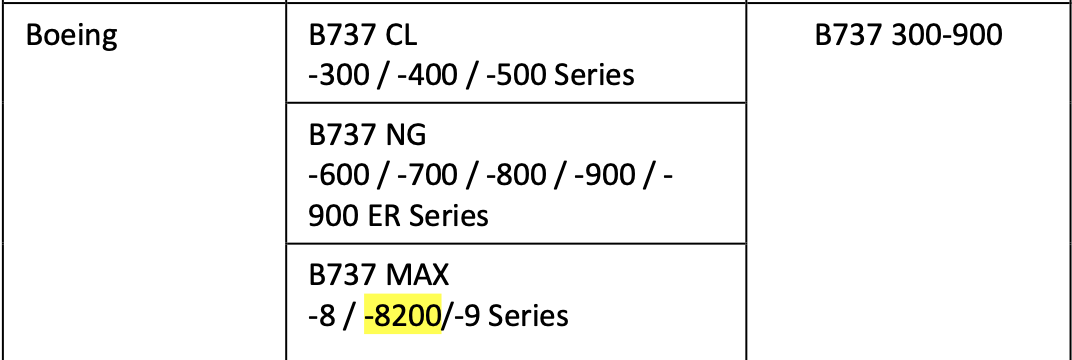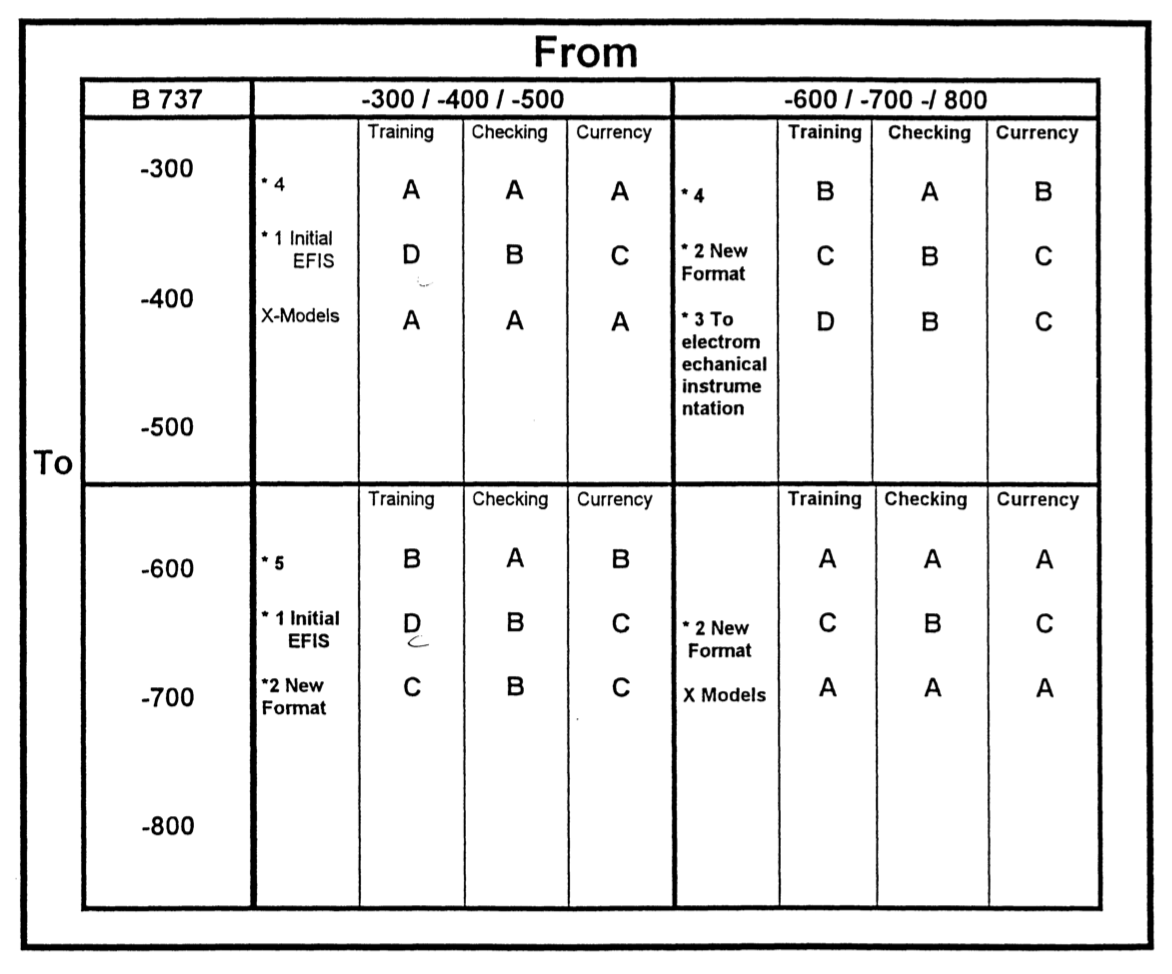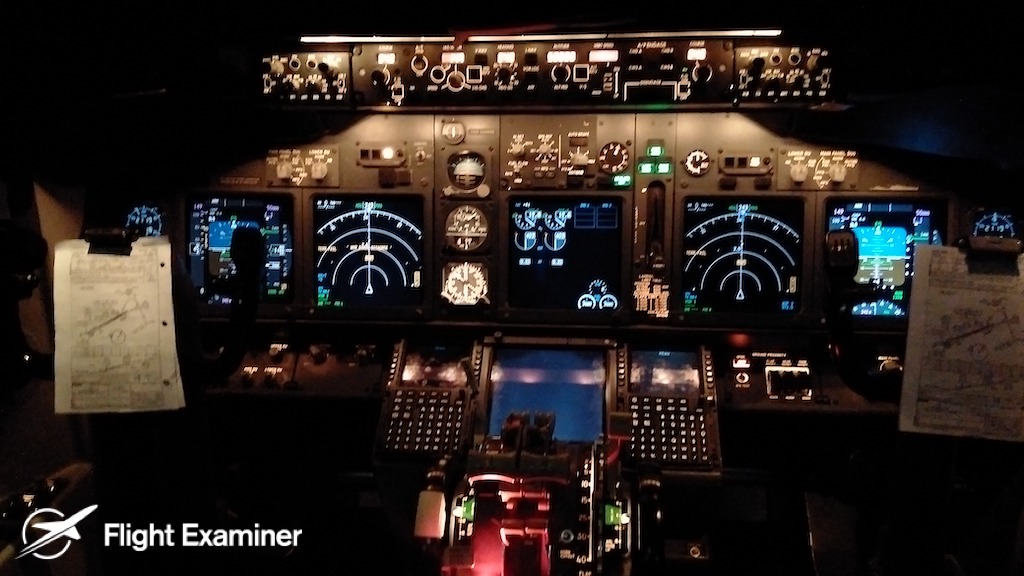Differences training Boeing 737
EASA established two different license endorsements for the Boeing 737 in its EASA typeratings endorsement list. Unlike the US regulator FAA and many other aviation authorities, in EASA the Boeing 737 is splited into two differetn type ratings. One of them is the older variant Boeing 737-200, which allows flying on Boeing 737-100, B737-200 and B737-200 / Adv variants which are very rare in EASA airspace.
Another Boeing 737 license endorsement is the Boeing 737 300-900 type rating. This license endorsement entitles the holder to fly on the following variants of Boeing 737 family:
- Boeing 737-300
- Boeing 737-400
- Boeing 737-500
- Boeing 737-600
- Boeing 737-700 and BBJ, BBJ1
- Boeing 737-800 and BBJ2
- Boeing 737-900
- Boeing 737-900 ER and BBJ3
- Boeing 737 MAX-8 and BBJ MAX 8
- Boeing 737 MAX-8200
- Boeing 737 MAX-9 and BBJ MAX 9
The common type rating license endorsement is the answer of Boeing to the common typerating endorsement concept introduced by the European Airbus in the case of the Airbus A320 Family.
However, obtaining a Boeing 737 type rating for one of the variants of the Boeing 737 does not automatically mean authorization to fly all different variants constituting into the same type rating license endorsement. Additional training is required to fly another variant of the Boeing 737. The duration and content of the differences training depends on the differences levels of each particular variants. The additional training can be as less as the theoretical knowledge instruction or so-called "to acquire additional knowledge". Additional training in simulator can also be required in case of more complex variants or significant differences.
These differences and additional training is basically regulated by Part-FCL which mandates the familiarization training or differences training.
On which variant of Boeing 737 can I fly... ✅
Upon the completion of the type rating training course you have to pass the checkride with EASA TRE B737 or SFE B737. Your Boeing 737 typerating privileges are limited to the variant on which the skill test with the B737 examiner was performed. To fly on another variant of the Boeing 737, differences training is required according to the difference levels among the B737 variants. Those difference levels are established by an EASA OSD FC B737. Transitions between more complex variants of Boeing 737 family also require partial proficiency check with EASA TRE B737 or SFE B737.
When it comes to Boeingu 737 the following generations apply:
- Boeing 737 Classic
- Boeing 737 NG
- Boeing 737 MAX
Type training training for issue of Boeing 737 is always completed in a simulator that represents one of the B737 generations.
Unless otherwise specified by EASA Operational suitability data then following apply:
- B737 variants in same cell (same generation of Boeing 737) - familiarization training required
- B737 variants in other cell (other generation of Boeing 737) - differences training required

Differences training to another Boeing 737 generation
Differences training and checking with the EASA TRE B737 to another variant of the Boeing 737 variants depends on the master differences between the particular B737 variants. For this purpose, the US FAA established a table of Master Differences Requirements between Boeing 737 variants as follows.

Following applies for the Master differences
- Level A differences - training delivered by selfstudy means
- Level B differences - instructor guided instruction or CBT
- Level C differences - system familiarization (Full task CBT)
- Level D differences - differences training required using the FTD or FFS Level A/B
- Level E differences - differences training required using the FFS Level C/D, or an aircraft
Boeing 737 Differences training ✅
When generally speaking about the Boeing 737 the differences training is always required when the transition is done from one generation to another generation of Boeing 737. It means, if you are a holder of privileges to fly a Boeing 737 Classic and want to operate Boeing 737 NG - so the following variants B737-700, B737-800, B737-900, or B737-900ER, additional flight training in simulator is required. Its scope is within the discretion of flight school.
Differences training requires to acquire additional experience. Usually in simulator and at the later stage also by the line training - so-called LIFUS means.
Boeing 737 Familiarization training ✅
Should you have attended the proficiency check or skill test in so-called classic Generation, means the variants of Boeing 737 Classic (B737-300, B737-400, or B737-500), the transition to the variants among the classic Generation, the familiarization training is required. The familiarization training requires to acquire additional knowledge by self-study or by CBT. This training is usually required at Level A or Level B differences. It applies in case of the transition between the variants of the same Boeing 737 generation.
Boeing 737 Training areas of special emphasis
During the transition to another variant of Boeing 737, it is necessary to undergo additional training, during which the emphasis is on specific areas.
In case of Boeing 737 additional training is generally required in following cases:
- transition from Boeing 737CL EFIS to Boeing 737 non-EFIS
- transition from Boeing 737CL to Boeing 737NG
- transition from Boeing 737NG to Boeing 737MAX
- transition to Blended, Split Scimitar, and Advanced Technology Winglet
- Roll Command Alerting System
- Runway Situational Awareness Tools
- Rockwell Collins Head-Up Guidance System (HGS)-4000 and HGS-6000
- Integrated Standby Flight Display (ISFD)
- Display Installation. Universal avionics flat panel display/FMS installations (Supplemental Type Certificate (STC)
- Future Air Navigation System (FANS)
- Alternate Navigation System (ANS)
- FMS for 737NG and 737 MAX
Transition from Boeing 737 NG to B737MAX
World-famous issues brought special areas of training emphasis for the transition from Boeing 737NG to Boeing 737 MAX. In this case, comprehensive theoretical instruction as well as simulator training is required.
Theoretical knowledge instruction to Boeing 737 MAX:
- Runaway Stabilizer.
- SPEED TRIM FAIL.
- STABILIZER OUT OF TRIM.
- Stabilizer Trim Inoperative.
- Airspeed Unreliable.
- ALT DISAGREE.
- AOA DISAGREE.
1.2.1 ATA 22 – Autoflight – FCC – MCAS:
- MCAS function description.
- Conditions for operation.
- Erroneous FCC trim commands.
- Flight deck alerting of the failure of the MCAS function.
1.2.2 ATA 22 – Autoflight – FCC – AFDS:
- Automatic AP disengagement.
- Temporary FD removal.
- AFDS pitch mode changes following stick shaker.
- Inhibiting of AP nose up trim.
1.2.3 ATA 22 – Autoflight – FCC – STAB OUT OF TRIM:
- Alert illumination logic (ground vs. flight).
- Revised NNC.
1.2.4 ATA 22 – Autoflight – FCC – SPEED TRIM FAIL:
- Function of the SP
- Revised NNC
737 Manual Trim Operation:
- Manual stabilizer trim operation.
- Manual stabilizer trimming techniques.
- Effects of airspeed and aerodynamic loads on manual stabilizer trim operation.
737 Unreliable Airspeed – Determining a Reliable Airspeed:
- Recognition of flight deck effects of an unreliable airspeed condition.
- Memory pitch and thrust settings associated with the NNC.
- Determination of reliable airspeed indication.
Boeing 737 MAX training requirement:
Demonstration of MCAS activation accomplished by each pilot acting as PF.
- MCAS activation during an impending stall (or full stall) and recovery demonstration during manual flight in a clean configuration.
Demonstrate MCAS activation stabilizer trim responses:
- Stabilizer trim in the nose down direction when above threshold AOA for MCAS activation during stall.
- Stabilizer trim in the nose up direction when below threshold AOA for MCAS activation during recovery.
Runaway stabilizer condition requiring use of manual stabilizer trim accomplished by each pilot acting as PF.
- Runaway stabilizer training
- Operation of each manual trim technique (as defined by Boeing).
- This training can be completed in a 737 MAX or 737NG FFS.
Use of manual stabilizer trim during approach, G/A, and level off by each pilot acting as PF.
-
Use of manual stabilizer trim as described in subparagraph
-
this training can be completed in a 737 MAX or 737NG FFS.
A Cross-FCC Trim Monitor activation demonstration accomplished by either pilot acting as PF.
- Condition must terminate in a landing in order to demonstrate the updated STAB OUT OF TRIM light functionality.
Erroneous high AOA during takeoff that leads to an unreliable airspeed condition accomplished by either pilot acting as PF.
- Demonstrates flight deck effects (i.e., aural, visual, and tactile) associated with the failure.
- Fault occurring during the takeoff procedure.
- Must include a go-around or missed approach flown with erroneous high AOA condition.
- Special emphasis placed on FD behavior biasing out of view upon selecting takeoff/go-around (TO/GA).
Transition from Boeing 737 Classic to B737NG
When transition from Boeing 737 Classic to next generation, at least 12 hours of CBT and 6 hours in FTD simulator is required. The differences training is focused on:
- Flight Mode Annunciator (FMA) differences.
- AFDS status annunciator.
- Vertical speed display.
- Airspeed bugs and flap maneuvering speeds.
- Compass rose.
- Pitch limit indicator.
- Airspeed trend vector.
- Minimum and maximum speeds.
- Landing altitude reference bar.
- Altimeter setting.
- Localizer (LOC) and glideslope (GS) deviation.
- Selected altitude indication (BUG).
- Ground speed display.
- Radio altitude display.
- Traffic Alert and Collision Avoidance System (TCAS) resolution advisories.
- Time critical warnings.
- Approach reference area.
- Marker beacon indication.
- System failures and flags.
- No “compact display” (display unit (DU) switching only).
Differences between B737 variants
With regard to the identified Boeing 737 differences, it is usually necessary to attend the line training - so-called LIFUS when the transition to another generation of Boeing 737 is made. The scope of line training and number of line sectors depends on the differences of the transitioned variant as well as Operator. Nevertheless in Commercial Air Transport the minimum sectors are specified in Operations Manual, Part D. However, the FAA establishes the following requirements when transition to a another variant or generation of a Boeing 737 is made:
.png)
Boeing 737 Differences training validity
Differences training to another Boeing 737 variant is valid 2 years since the last flight on the particular B737 variant. That is required by FCL.710(b). In case if you have not flown particular variant for more than 2 years, you will need an additional training.

--
Looking for a reliable Boeing 737 differences training provider? ProfiPilot Training is the professional flight school of your choice.


 Differences training is the training to different variants of Boeing 737 family.
Differences training is the training to different variants of Boeing 737 family.